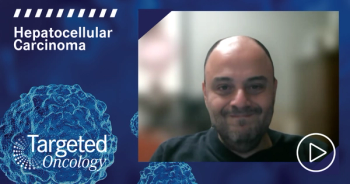
Liver Cancer Awareness Month: A Decade of Progress and Hope in Hepatocellular Carcinoma

Mahvish Muzaffar, MD, and Nasreen Vohra, MD, from the Brody School of Medicine/East Carolina University, discuss the past decade of progress in treatment for patients with hepatocellular carcinoma.
The Epidemiology of Hepatocellular Carcinoma
Liver cancer is the seventh most common cancer and second most common cause of cancer related deaths.1 Hepatocellular carcinoma (HCC) is the most common type of liver cancer with significant global variation in etiology and outcome. Viral hepatitis associated cirrhosis is the main risk factor for HCC but impact of non-alcoholic steatohepatitis (NASH) as a risk factor for HCC is increasing in the west.
In the United States, liver cancer incidence has been increasing for decades, with recent data suggesting some decrease in incidence among younger adults is plateauing. Previously, increasing death rates from liver cancer has improved but hepatobiliary cancers continue to be the 6th and 7th leading cause of cancer related deaths among men and women, respectively.2
How Screening and Surveillance Impacts HCC
Impact of routine surveillance on HCC survival is conflicting. The recommendation for screening patients for HCC varies among different medical societies. Most medical societies recommend screening for HCC in patients at high risk, so patients with cirrhosis irrespective of etiology and Child-Pugh Class A and B, and Child-Pugh C awaiting liver transplantation. Patients without cirrhosis and hepatitis B virus infection and additional high-risk features, such as active hepatitis, a family history of HCC, race, and age, might not have to consider HCC right away.
Most societies recommend using ultrasound as the imaging modality of choice with or without AFP every 6 months in high-risk patients if patients have no other significant comorbidities. However, overall adherence to screening and surveillance guidelines among high-risk patients is low.3
A Decade of Treatment Progress in HCC
Surgical resection, or liver transplant, provides the best outcome for patients with HCC at an early stage. Unfortunately, the majority pf patients are not eligible for these curative treatment options due to the advanced stage of disease, severity of liver dysfunction, and limited availability of liver allografts. Still, the treatment landscape for patients with advanced HCC has shown considerable progress in the last decade after years of failed clinical trials.
Sorafenib (Nexavar) was the first tyrosine kinase inhibitor (TKI) approved for patients with HCC based on the SHARP trial (NCT00105443), which demonstrated improved overall survival (OS) compared to placebo at 10.7 months vs 7.9 months, respectively.4 At the time, this was the only treatment option for patients with advanced HCC, but more than 10 years later the FDA approved lenvatinib (Lenvima) in the first line setting for patients with advanced HCC and Child-Pugh A class disease.
This approval was based on an international, multicenter, randomized, open-label, non-inferiority REFLECT trial (NCT01761266), which confirmed noninferiority of lenvatinib, at a median OS of 13.6 months, compared to sorafenib, at a median OS of 12.3 months (HR 0.92,95% CI 0.79-1.06).5
Lenvatinib was associated with more hypertension compared to increased hand-foot syndrome with sorafenib, and the efficacy of immune checkpoint inhibitors in the first line setting for patients with advanced HCC has resulted in mixed outcome.
Clinical trials with single agent immune checkpoint inhibitor nivolumab (Opdivo) vs sorafenib and pembrolizumab (Keytruda) vs placebo did not achieve the prespecified end point for survival efficacy but confirmed durable responses and a better adverse event (AE) profile. These studies highlight the complex interplay of tumor and microenvironment and a role for combination therapies in patients with advanced HCC.
In 2020, the FDA approved atezolizumab (Tecentriq) in combination with bevacizumab (Avastin) for patients with unresectable or metastatic HCC in the first line setting.6 The approval was based on the randomized phase 3 IMbrave150 trial (NCT03434379) that looked at 1200 mg of atezolizumab with 15 mg/kg of bevacizumab given intravenously every 3 weeks compared to sorafenib given orally twice daily.
This combination leverages dual effect on immune modulation by inhibiting VEGF and program cell death protein-1 signaling and demonstrated improved OS with bevacizumab and atezolizumab compared to sorafenib. Recent updated analysis reported a median OS of 19.2 months with atezolizumab plus bevacizumab (HR 0.66, 95% CI 17.0–23.7) compared with 13.4 months with sorafenib.
The most common AEs with the combination are hypertension, fatigue, and proteinuria. This combination has now become standard of care for patients with advanced HCC with Child Pugh A and no contraindications.7
Dual immunotherapy combination has shown promising results in different cancers including HCC. Recently, the phase 3 HIMALAYA trial (NCT03298451) demonstrated that a single priming dose of 300-mg dose of the CTLA-4 monoclonal antibody tremelimumab and the PD-L1 inhibitor durvalumab (Imfinzi) at 1,500 mg every 4 weeks. Single agent durvalumab was also noninferior to sorafenib.8 The FDA approved tremelimumba(Imjudo) in combination with durvalumab for adult patients with unresectable HCC on October 21st, 2022.
Clinical trials assessing TKIs and immune checkpoint inhibitor combination has shown conflicting results. For example, the lenvatinib and pembrolizumab combination in the phase 3 LEAP-002 trial (NCT03713593) in the first line for patients with advanced HCC was negative.
Multiple treatment options are now available for the second line setting in advanced HCC with CTP-A as well. Regorafenib (Stivarga) is a potent multi-kinase inhibitor approved for patients with HCC(CTP-A) and after exposure to sorafenib. This approval was based on the RESOURCE trial (NCT01774344), a phase 3 randomized double-blind, parallel-group, trial which demonstrated efficacy. Regorafenib improved OS with a hazard ratio of 0.63 (95% CI, 0.50-0.79: one-sided P < .0001). Hypertension, hand-foot syndrome, fatigue, and diarrhea were the most common grade 3 or 4 AEs.9
Cabozantinib (Cabometyx) is one of the multikinase inhibitors which inhibits multiple VEGFR, MET, and AXL and is approved in patients with advanced HCC (CTA-A) who have progressed after sorafenib.10 In a randomized double-blind phase 3 trial showed improved OS of 10.2 months with cabozantinib vs 8 months with placebo and a hazard ratio of 0.76 (95% CI, 0.63-0.92; P = .005). The most common AEs associated with cabozantinib were also hand-foot syndrome, hypertension, fatigue, and liver dysfunction.
Now, ramucirumab (Cryamza) is a monoclonal antibody that inhibits activation of VEGF receptor 2 (VEGFR2) and is approved for patients with advanced HCC (CTP-A) and elevated alpha feta protein greater than or equal to 400 ng/dl. Additional treatment options in certain circumstances include sorafenib (CTP A, B7) and Lenvatinib (CTA-A).
Immune checkpoint inhibitors also offer some efficacy in phase I/II studies for the second line treatment. Nivolumab alone or in combination with ipilimumab and pembrolizumab alone are also options in select patients that can be considered under certain circumstances.11
The Promising Future Direction for This Patient Population
These advances have resulted in a paradigm shift in the management of patients with advanced HCC. The combination of atezolizumab and bevacizumab is at present the preferred first line therapy in unresectable or advanced HCC (CTP-A).
The immunotherapy combination of a PD-1 inhibitor,Durvalumab(Imfinzi) with a CTLA-4 single priming dose of Tremelimumab (Imjudo) was approved by FDA on Oct 21st,2022 and provides an option for patients who are not candidates for anti VEGF based combination. Moreover, single agent clinical trials in HCC have increased our understanding of the immunogenicity of HCC itself.
Many ongoing clinical trials are focusing on combination therapies, aimed at harnessing potentially additive/synergistic immune modulations which may translate in increased and durable efficacy.12 Multiple new treatment options have been approved in the first line setting, but lack of predictive biomarkers highlights this unmet need when identifying the best sequence for our patients. Now, the treatment paradigm for patients with advanced HCC has shifted towards a path of hope and progress.
References:
1. Bray F, Ferlay J, Soerjomataram I, Siegel RL, Torre LA, Jemal A. Global cancer statistics 2018: GLOBOCAN estimates of incidence and mortality worldwide for 36 cancers in 185 countries [published correction appears in CA Cancer J Clin. 2020 Jul;70(4):313]. CA Cancer J Clin. 2018;68(6):394-424. doi:10.3322/caac.21492
2. Siegel RL, Miller KD, Fuchs HE, Jemal A. Cancer statistics, 2022. CA Cancer J Clin. 2022;72(1):7-33. doi:10.3322/caac.21708
3. Harris PS, Hansen RM, Gray ME, Massoud OI, McGuire BM, Shoreibah MG. Hepatocellular carcinoma surveillance: An evidence-based approach. World J Gastroenterol. 2019;25(13):1550-1559. doi:10.3748/wjg.v25.i13.1550
4. Llovet JM, Ricci S, Mazzaferro V, et al. Sorafenib in advanced hepatocellular carcinoma. N Engl J Med. 2008;359(4):378-390. doi:10.1056/NEJMoa0708857
5. Kudo M, Finn RS, Qin S, et al. Lenvatinib versus sorafenib in first-line treatment of patients with unresectable hepatocellular carcinoma: a randomised phase 3 non-inferiority trial. Lancet. 2018;391(10126):1163-1173. doi:10.1016/S0140-6736(18)30207-1
6. FDA approves atezolizumab plus bevacizumab for unresectable hepatocellular carcinoma. FDA. June 1st, 2020. Accessed: October 21, 2022. https://bit.ly/3sdTKsb
7. Finn RS, Qin S, Ikeda M, et al. Atezolizumab plus Bevacizumab in Unresectable Hepatocellular Carcinoma. N Engl J Med. 2020;382(20):1894-1905. doi:10.1056/NEJMoa1915745
8. Ghassan K. Abou-Alfa,et.al Phase 3 randomized, open-label, multicenter study of tremelimumab (T) and durvalumab (D) as first-line therapy in patients (pts) with unresectable hepatocellular carcinoma (uHCC): HIMALAYA. J Clin Oncol. 40(4_suppl):379-379. doi: 10.1200/JCO.2022.40.4_suppl.379
9. Bruix J, Qin S, Merle P, et al. Regorafenib for patients with hepatocellular carcinoma who progressed on sorafenib treatment (RESORCE): a randomized, double-blind, placebo-controlled, phase 3 trial [published correction appears in Lancet. 2017 Jan 7;389(10064):36]. Lancet. 2017;389(10064):56-66. doi:10.1016/S0140-6736(16)32453-9
10. Trojan J. Cabozantinib for the Treatment of Advanced Hepatocellular Carcinoma: Current Data and Future Perspectives. Drugs. 2020 Aug;80(12):1203-1210. doi: 10.1007/s40265-020-01361-5
11. Llovet JM, Kelley RK, Villanueva A, et al. Hepatocellular carcinoma. Nat Rev Dis Primers. 2021;7(1):6. Published 2021 Jan 21. doi:10.1038/s41572-020-00240-3
12. Bejjani AC, Finn RS. Hepatocellular Carcinoma: Pick the Winner-Tyrosine Kinase Inhibitor Versus Immuno-oncology Agent-Based Combinations. J Clin Oncol. 2022;40(24):2763-2773. doi:10.1200/JCO.21.02605








































